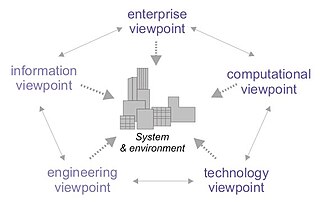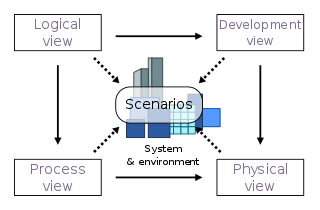Related Research Articles

Software architecture is the set of structures needed to reason about a software system and the discipline of creating such structures and systems. Each structure comprises software elements, relations among them, and properties of both elements and relations.
ISO/IEC/IEEE 12207Systems and software engineering – Software life cycle processes is an international standard for software lifecycle processes. First introduced in 1995, it aims to be a primary standard that defines all the processes required for developing and maintaining software systems, including the outcomes and/or activities of each process.
Architecture description languages (ADLs) are used in several disciplines: system engineering, software engineering, and enterprise modelling and engineering.

The Department of Defense Architecture Framework (DoDAF) is an architecture framework for the United States Department of Defense (DoD) that provides visualization infrastructure for specific stakeholders concerns through viewpoints organized by various views. These views are artifacts for visualizing, understanding, and assimilating the broad scope and complexities of an architecture description through tabular, structural, behavioral, ontological, pictorial, temporal, graphical, probabilistic, or alternative conceptual means. The current release is DoDAF 2.02.
A software design description is a representation of a software design that is to be used for recording design information, addressing various design concerns, and communicating that information to the design’s stakeholders. An SDD usually accompanies an architecture diagram with pointers to detailed feature specifications of smaller pieces of the design. Practically, the description is required to coordinate a large team under a single vision, needs to be a stable reference, and outline all parts of the software and how they will work.
The British Ministry of Defence Architecture Framework (MODAF) was an architecture framework which defined a standardised way of conducting enterprise architecture, originally developed by the UK Ministry of Defence. It has since been replaced with the NATO Architecture Framework.
The ISO/IEC 15288 is a technical standard in systems engineering which covers processes and lifecycle stages, developed by the International Organization for Standardization (ISO) and the International Electrotechnical Commission (IEC). Planning for the ISO/IEC 15288:2002(E) standard started in 1994 when the need for a common systems engineering process framework was recognized. The previously accepted standard MIL STD 499A (1974) was cancelled after a memo from the United States Secretary of Defense (SECDEF) prohibited the use of most U.S. Military Standards without a waiver. The first edition was issued on 1 November 2002. Stuart Arnold was the editor and Harold Lawson was the architect of the standard. In 2004 this standard was adopted by the Institute of Electrical and Electronics Engineers as IEEE 15288. ISO/IEC 15288 has been updated 1 February 2008 as well as on 15 May 2015.

An enterprise architecture framework defines how to create and use an enterprise architecture. An architecture framework provides principles and practices for creating and using the architecture description of a system. It structures architects' thinking by dividing the architecture description into domains, layers, or views, and offers models – typically matrices and diagrams – for documenting each view. This allows for making systemic design decisions on all the components of the system and making long-term decisions around new design requirements, sustainability, and support.

Reference Model of Open Distributed Processing (RM-ODP) is a reference model in computer science, which provides a co-ordinating framework for the standardization of open distributed processing (ODP). It supports distribution, interworking, platform and technology independence, and portability, together with an enterprise architecture framework for the specification of ODP systems.
The ISO/IEC/IEEE 42010 Conceptual Model of Architecture Description defines the term architecture framework within systems engineering and software development as:

4+1 is a view model used for "describing the architecture of software-intensive systems, based on the use of multiple, concurrent views". The views are used to describe the system from the viewpoint of different stakeholders, such as end-users, developers, system engineers, and project managers. The four views of the model are logical, development, process and physical view. In addition, selected use cases or scenarios are used to illustrate the architecture serving as the 'plus one' view. Hence, the model contains 4+1 views:
ISO/IEC/IEEE 42010Systems and software engineering — Architecture description is an international standard for architecture descriptions of systems and software.
A concept of operations is a document describing the characteristics of a proposed system from the viewpoint of an individual who will use that system. Examples include business requirements specification or stakeholder requirements specification (StRS). CONOPS is used to communicate the quantitative and qualitative system characteristics to all stakeholders. CONOPS are widely used in the military, governmental services and other fields.

ArchiMate is an open and independent enterprise architecture modeling language to support the description, analysis and visualization of architecture within and across business domains in an unambiguous way.

A view model or viewpoints framework in systems engineering, software engineering, and enterprise engineering is a framework which defines a coherent set of views to be used in the construction of a system architecture, software architecture, or enterprise architecture. A view is a representation of the whole system from the perspective of a related set of concerns.

TRAK, or The Rail Architecture Framework, is a general enterprise architecture framework aimed at systems engineers. It is based on MODAF 1.2.
DUALLy is an MDE framework to create interoperability among Architecture Description Languages (ADLs). It is developed at the Computer Science Department of the University of L'Aquila. DUALLy enables the transformation of a model conforming to a specific architecture description language into corresponding models conforming to other architecture description languages.
Software architecture description is the set of practices for expressing, communicating and analysing software architectures, and the result of applying such practices through a work product expressing a software architecture.
References
- 1 2 3 4 5 ISO/IEC 42010:2007, Systems and Software Engineering -- Architecture Description
- ↑ ISO/IEC/IEEE 42010:2011, Systems and software engineering — Architecture description, the latest edition of the original IEEE Std 1471:2000, last update 5 February 2014
- 1 2 Architecture and Change Archived 2009-06-19 at the Wayback Machine
- ↑ Description of IEEE 1471
- ↑ IEEE Std 610.12−1990, IEEE Standard Glossary of Software Engineering Terminology.
- ↑ IEEE 1471 Conceptual Framework
- 1471-2000 - IEEE Recommended Practice for Architectural Description of Software-Intensive Systems. 2000. doi:10.1109/IEEESTD.2000.91944. ISBN 0-7381-2518-0.